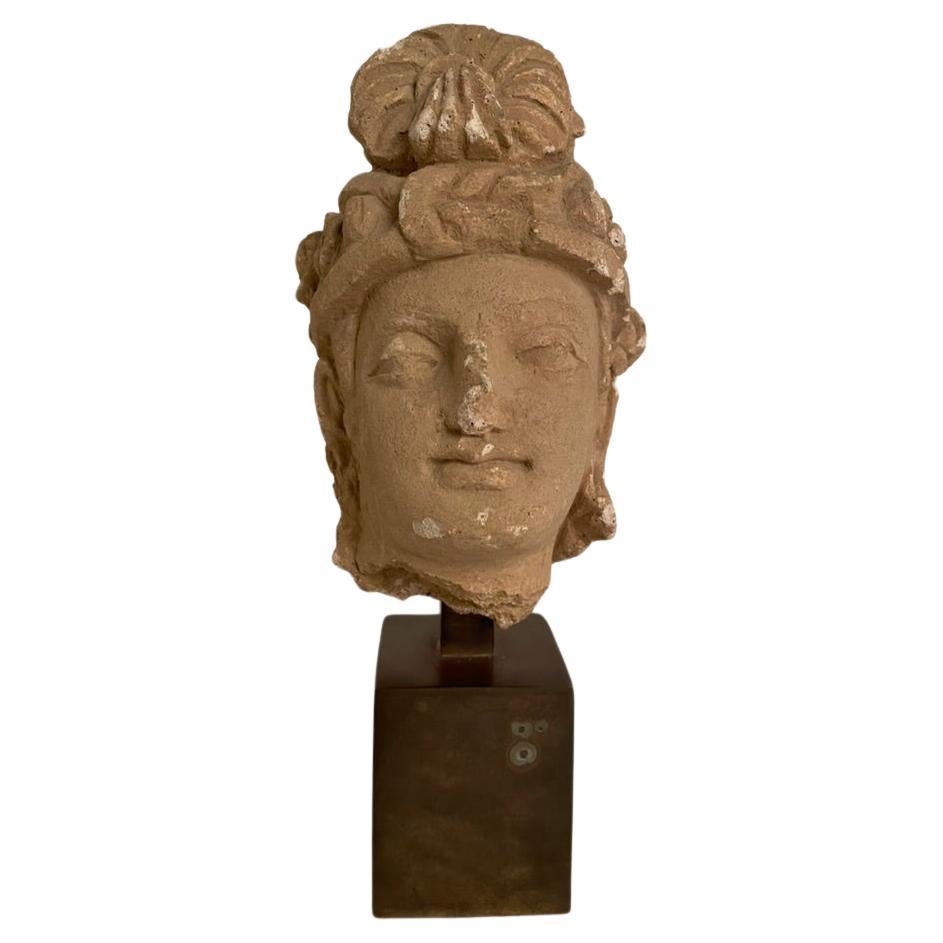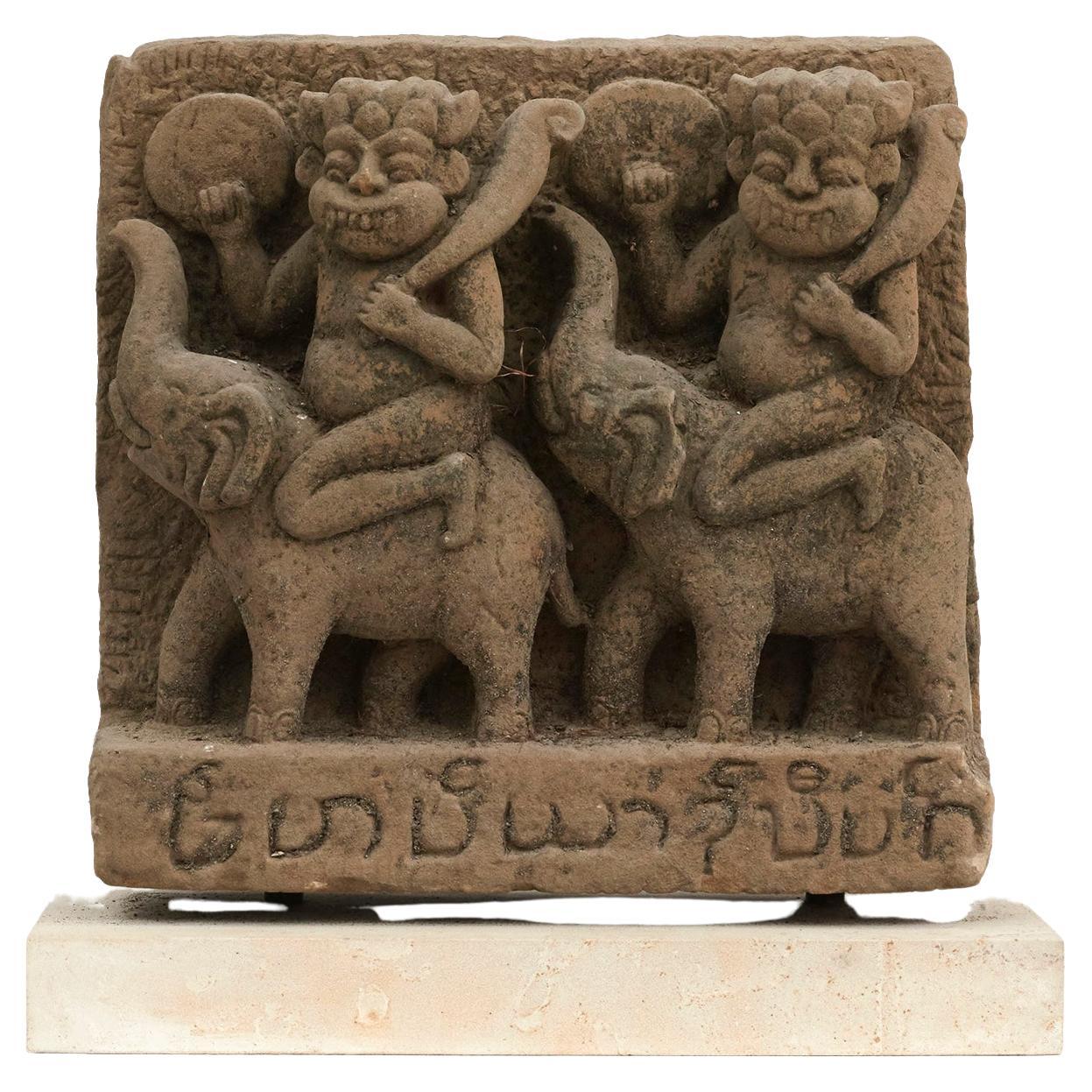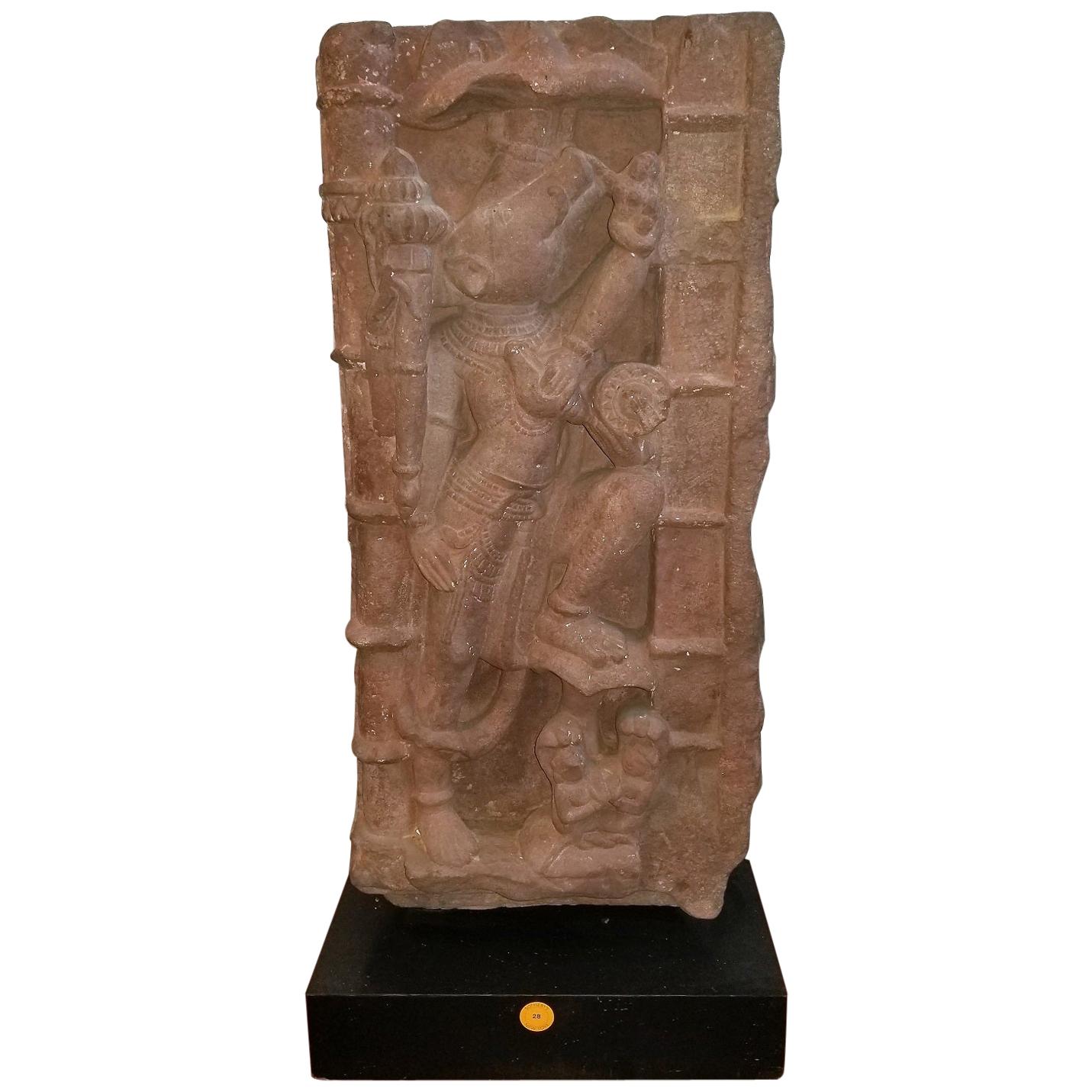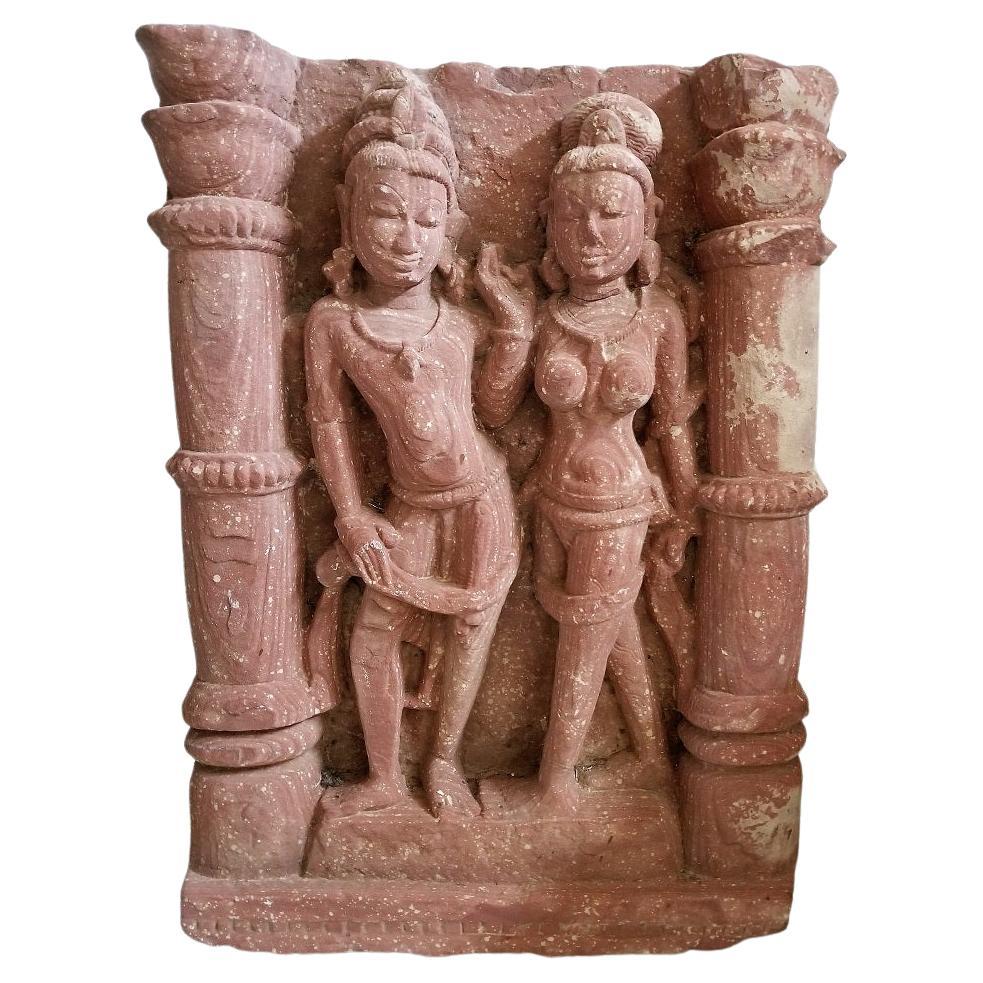Items Similar to 3rd Century Red Sandstone Elephant
Want more images or videos?
Request additional images or videos from the seller
1 of 13
3rd Century Red Sandstone Elephant
About the Item
PRESENTING a STUNNING piece of Indian Antiquity from circa the 3rd Century, namely, a 3rd Century Red Sandstone Elephant .
From Central India.
The piece was purchased by a Private Dallas Collector at Sotheby’s or Christies of New York Auction pre-2004.
Sotheby’s and Christies operate a twice yearly auction of Southeast Asian Art & Antiquities in New York in the months of March and September.
The sculpture is a section of a larger sculpture carved from a block of red sandstone and features, in relief, an elephant in tribal dress.
it sits on a wooden plinth but does not retain the original Auction Label which would have been on the plinth. The location of the circular label (most likely from Sotheby’s) is still visible on the plinth.
We have not yet located the catalog for this piece as their records for auction sales pre 2006 are no longer available online, but we have no doubt that it was purchased by the private collector at one of those 2 auctions houses as is evidenced from the rest of the collection in our Inventory.
It has substantially increased in value over the years as a RARE piece from a prestigious Collection and a RARE piece of Asian antiquity.
- Dimensions:Height: 10.25 in (26.04 cm)Width: 8 in (20.32 cm)Depth: 3.5 in (8.89 cm)
- Style:Medieval (Of the Period)
- Materials and Techniques:
- Place of Origin:
- Period:
- Date of Manufacture:300
- Condition:Wear consistent with age and use. Very good original condition. The plinth has some wear.
- Seller Location:Dallas, TX
- Reference Number:1stDibs: LU3978117101491
About the Seller
4.9
Platinum Seller
These expertly vetted sellers are 1stDibs' most experienced sellers and are rated highest by our customers.
Established in 2015
1stDibs seller since 2018
349 sales on 1stDibs
Typical response time: <1 hour
- ShippingRetrieving quote...Ships From: Dallas, TX
- Return PolicyA return for this item may be initiated within 7 days of delivery.
More From This SellerView All
- 2nd Century Indian Red Sandstone Fragment of a WomanLocated in Dallas, TXPresenting a stunning little piece of Southeast Asian Indian Antiquity, namely, a Double-sided 2nd Century Red Sandstone Fragment of a Woman. From India, Uttar Pradesh, Mathura. This piece has impeccable Provenance ! It was purchased by a Private Dallas Collector at Christie’s New York Auction on 31st March 2005. Sale Number 1492, Lot No. 43. Christie’s operate a twice yearly auction of Southeast Asian Art & Antiquities in New York in the months of March and September. The sculpture was described as “Property of a European Estate. A Double-sided Red Sandstone Fragment of a Woman. India, Uttar Pradesh, Mathura, Circa 2nd Century.” “Both sides similarly depicting the lower body with a flared sash at left and remains of chained belt: marked with an accession number 1931 on reverse. 8 in (29.2 cm.) high” Provenance: Collection of Prince and Princess Aschwin zur Lippe-Biesterfeld, acquired on 1958?. It carried an Auction estimate of USD 3,000 to USD 5,000 and Sold for USD 2,880 (not including Buyers Premium). Allowing for inflation alone this would be over $6,300 in today’s value. It has substantially increased in value over the years as a RARE piece from a prestigious Collection and a RARE piece of antique Asian antiquity...Category
Antique 15th Century and Earlier Indian Medieval Antiquities
MaterialsSandstone
- 10th Century Varaha Red Sandstone Central, IndiaLocated in Dallas, TXPresenting a stunning piece of Indian antiquity from the 10th century, namely, a Varaha red sandstone central India carving. From Central India. This piece has impeccable Provenance! It was purchased by a Private Dallas collector at Sotheby’s New York Auction on 24th September 2004. Sale Number 8008, Lot No. 28. Sotheby’s operate a twice yearly auction of Southeast Asian Art & Antiquities in New York in the months of March and September. The sculpture was described as: "Carved in relief with Vishnu in his boar incarnation stepping forward from the ocean, his left foot placed upon a lotus, two nagas beneath with their hands clasped in devotion. Vishnu’s primary right hand rests on his thigh in katihasta mudra while his remaining hands carry his attributes of mace, conch and discus. A diminutive figure of the earth Goddess, Bhudevi, whom Vishnu has rescued from the primeval waters, is balanced on his left elbow. The figure is bejeweled, wearing a broad, beaded waistband and necklaces and is placed within a niche between two pillars. Measure: Height 27 in. (68.6 cm.), circa 10th century. Provenance: Sotheby’s New York, March 21 & 22, 1990, Lot 253 Catalogue Note: This zoomorphic representation of Vishnu gained popular currency during the medieval period and was widely depicted in Central Indian Temple sculpture...Category
Antique 15th Century and Earlier Indian Archaistic Sculptures and Carvings
MaterialsSandstone
- 10th Century Red Sandstone Relief of a Mithuna CoupleLocated in Dallas, TXPresenting a stunning piece of southeast Asian antiquity, namely, a 10th century red sandstone relief of a mithuna couple. This piece has impeccable Provenance! It was purchase...Category
Antique 15th Century and Earlier Indian Archaistic Antiquities
MaterialsSandstone
- 10th Century Temple Bracket Buff Sandstone Central IndiaLocated in Dallas, TXPresenting a stunning piece of Indian antiquity from the 10th century, namely, a temple bracket buff sandstone central India carving. From Central In...Category
Antique 15th Century and Earlier Indian Archaistic Sculptures and Carvings
MaterialsSandstone
- 11C Ambika Buff Sandstone Western IndiaLocated in Dallas, TXPresenting a stunning piece of Indian antiquity from the 11th century, namely, a 11C Ambika Buff Sandstone Western India carving. From Western India. ...Category
Antique 15th Century and Earlier Indian Archaistic Sculptures and Carvings
MaterialsSandstone
- Vishnu Seated on Garuda Buff Sandstone Central IndiaLocated in Dallas, TXPresenting a stunning piece of Indian antiquity from the 12th century, namely, a Vishnu Buff Sandstone Central India. From Central India. This piece has impeccable Provenance ! It...Category
Antique 15th Century and Earlier Indian Archaistic Antiquities
MaterialsSandstone
You May Also Like
- Gandharan Stucco Head of a Bodhisattva, 3rd-5th CenturyLocated in Stamford, CTStucco head of a Bodhisattva, Gandhara, 3rd - 5th century AD. Mounted on a custom made brass base. 12 inches high ( head alone 8.2 in ) 5.5 wide 5 deep Provanance: Ex Sotheby's, old...Category
Antique 15th Century and Earlier Sculptures and Carvings
MaterialsStucco
- Gandharan Stucco Head of a Bodhisattva, Region of Hadda, 3rd-5th CenturyLocated in Austin, TXA striking Gandharan molded stucco head of a male Bodhisattva, tentatively identified as Manjushri, ancient region of Gandhara, probably Hadda or surrounding area, 3rd-5th century. The Bodhisattva is sculpted of stucco in an idealized manner as a youthful male, with soft and kind features, a benign expression on his face. He wears an elaborate pleated turban wrapped around his head, with two sweeping lobes at the front. His turban secured on one side by a small image of a roaring lion. The lion may be read as a reference to Manjushri, the Bodhisattva of Wisdom, who is often depicted as riding or subduing a roaring lion, a metaphor for taming the wild thoughts of the mind. Manjushri gazes outwards in a beatific manner from almond shaped eyes, a gentle smile on his lips. The eyes at different levels when looking at the sculpture head on, indicating the original placement of the head was meant to be viewed at an angle. Remnants of pigments to the eyes, nose, mouth and ears. Mounted on a custom black metal stand. Hadda was an important center of Buddhist learning in the early history of Greco Buddhist Gandhara, and at one time may have housed a bone relic of the historical Buddha, Shakyamuni. The sculpture and architecture of Hadda followed Hellenistic artistic conventions faithfully, leading some scholars to believe the distinct Greco Buddhist style of Gandhara was first developed in Hadda before spreading to the rest of the region. The kingdom of Gandhara was situated at a crossroads of trade and cultures. Being one of the last remnants of Alexander the Great's Empire, the inhabitants of the Greco-Bactrian Buddhist kingdom preserved Greek culture and heritage for centuries after the decline of the Greek Empire...Category
Antique 15th Century and Earlier Afghan Hellenistic Sculptures and Carvings
MaterialsStucco
- Sandstone Carving of Two Demons Riding on ElephantsLocated in Kastrup, DK500-600 year old sandstone carving. The sculpture is depicting 'Two demons riding on elephants'. From Buddha pagoda / temple in Arakan, Burma, 1400-1500. Untouched and in origin...Category
Antique 16th Century Burmese Other Figurative Sculptures
MaterialsSandstone
- Sandstone Carving of Two Demons Riding an Elephant, Burma 15-16'th CtrLocated in Kastrup, DK500-600 Year old sandstone carving. The sculpture is depicting 'Two demons riding an elephant at the pagoda'. From Buddha pagoda / temple in Arakan, Burma. Naive and charming in it...Category
Antique 15th Century and Earlier Burmese Other Figurative Sculptures
MaterialsSandstone
- Carved Sandstone Jain Family Group, 6th-7th Century, Uttar Pradesh, IndiaLocated in Austin, TXA fine and rare Indian carved sandstone stele of a Jain family group, Sarnath style, early Indian Medieval period, 6th-7th century, Uttar Pradesh, India. Carved from a single block of buff sandstone, the stele features a Jain family group comprised of a father, mother, and two children. The family group is portrayed upon a lotus pedestal under a tall palm tree. The mother and father both seated in a relaxed pose known as lalitasana, or royal ease pose, a jovial expression on their faces. The mother holds the daughter in her lap. The younger son scampers mischievously up the trunk of the palm tree, his head turned to look back at his parents. Above the family, nestled in a niche amongst the palm fronds, an image of a Jain Tirthankara...Category
Antique 15th Century and Earlier Indian Medieval Sculptures and Carvings
MaterialsSandstone
- Indian Carved Sandstone Frieze of Lakshmi, Central India, 10th-11th CenturyLocated in Austin, TXA large and impressive Indian carved sandstone architectural frieze featuring a central image of the Hindu goddess Lakshmi flanked by two atten...Category
Antique 15th Century and Earlier Indian Medieval Sculptures and Carvings
MaterialsSandstone





